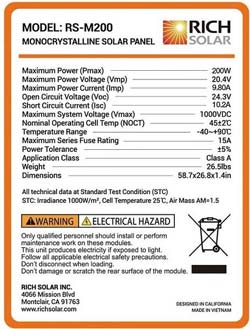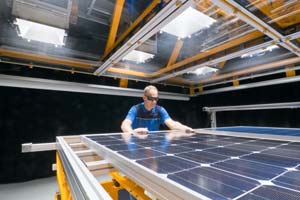
Standard Test Conditions
The STC of a Photovoltaic Module
![]() The standard test conditions, or STC of a photovoltaic solar panel is used by a manufacturer as a way to define the electrical performance and characteristics of their photovoltaic panels and modules.
The standard test conditions, or STC of a photovoltaic solar panel is used by a manufacturer as a way to define the electrical performance and characteristics of their photovoltaic panels and modules.
We know that photovoltaic (PV) panels and modules are semiconductor devices that generate an electrical output when exposed directly to sunlight. But the change in irradiance directly affects a PV panels current output. The selection of one type of PV panel over another can be based on any number of factors from size, price, power output and type, either monocrystalline or polycrystalline silicon.
The most important characteristic of any solar panel is its power output and photovoltaic solar panels are available in a wide range of power outputs ranging from a few watts to more than 400 watts for the bigger panels and/or modules. So their needs to be some way of determining a PV panels peak power output, in watts, as well as its electrical characteristics which is the same for all panel manufacturers for the user, homeowner, or installer to compare.

Generally, the power output rating of a particular PV panel is its DC rating that appears on the manufacturer’s label or nameplate on the back of the panel listing several STC values such as voltage, current, and wattage. For example, 100 WDC.
This power rating and therefore the performance of a photovoltaic panel is presented according to defined international testing criteria. Known as Standard Test Conditions (STC). Then when a panel is advertised as having a capacity of say, 400 Watts-peak, this is the power output it will produce under STC conditions.
The three main elements to the standard test conditions are “cell temperature”, “irradiance”, and “air mass” since it is these three basic conditions which affect a PV panels power output once they are installed.
Manufacturers want us to buy their photovoltaic panels and products so test them under controlled conditions so that the data they provide about their panels is reliable and repeatable during a series of tests when determining their peak performance. Generally, the test procedures used are based on the indoor measurements.
Photovoltaic PV panels convert the solar energy from the sun into electrical energy. But to do this they require a sufficient amount of solar irradiance to hit the surface of the panel. In solar terms, irradiance represents the intensity of sunlight falling on the solar panel. That is, irradiance is an instantaneous measurement of solar power over some area at some point in time with maximum irradiance present at noon on a clear day.
The standard test condition for a photovoltaic solar panel or module is defined as being 1000 W/m2 (1 kW/m2) of full solar irradiance when the panel and cells are at a standard ambient temperature of 25oC with a sea level air mass (AM) of 1.5 (1 sun). Moreover, ISC is the short-circuit current at STC and VOC is the open-circuit voltage.
Clearly, the standard test conditions used by the manufacturers are those found in laboratories or on their indoor assembly lines and as such are different from the realistic conditions the panels will endure on top of a roof or mounting frame.
Outdoor measurements on PV panels and modules (or arrays) have to be performed under the actual conditions of irradiance, temperature given at the time of the measurement. But there has to be something somewhere that the designer, or homeowner can use when selecting a particular panel or module.
The power (current x voltage) output of a photovoltaic (PV) panel under these standard test conditions is often referred to as “peak watts” or “Wp”. There is a particular point on the I-V curve of a PV panel called the Maximum Power Point (MPP), at which the panel operates at maximum efficiency and produces its maximum output power.
However, the I-V characteristics curve is nonlinear as the current generated by a solar panel varies linearly with the intensity of light and temperature. It should be noted here that this “peak power” term is a little misleading, because at extreme low temperature coefficients, or very high radiation intensities the peak wattage value can well be exceeded. The vast majority of solar panel installations operate within their peak values.
Photovoltaic Panel STC Label

The Nominal Operating Conditions (NOC) of a photovoltaic panel is a set of common reference conditions designed to simulate the panel for actual outdoor measurements.
They try to combine the irradiance level of a clear summer day, with a panel temperature of a clear winter day and the light spectrum of a clear spring day. These conditions assume a solar irradiance of 800 W/m2, and ambient temperature of 20oC, and a wind speed of 1.0 m/s at sea level.
Then clearly, the peak power output of a PV panel will be a lot less than those quoted under the standard test conditions. The comparisons between ideal indoor measurements under standard test conditions (STC) and real outdoor measurements under actual nominal operation conditions (NOC) can produce an output peak power, WP of less than 20% compared to the manufacturer’s rated peak power of a particular panel.
That is not to say a particular manufacturer’s STC output voltage, current and wattage ratings are not accurate. STC panel ratings can be used to compare different PV panels from different manufacture’s. But it is, however, only a reference number and in no way can it be used to characterise a photovoltaic panels or systems output. Then realising that your solar installation may produce less than you think, will remove any doubts about its effectiveness.
Standard Test Conditions Summary
Photovoltaic solar panels are a great way of reducing our carbon footprint by converting sunlight directly into electricity. Manufacturer’s want us to buy their PV panels and modules and use the measurements obtained under their Standard Test Conditions (STC) in a laboratory environment to do just that. But a PV panels performance under perfect indoor STC measurements and actual operation conditions when mounted on a rooftop or support can vary greatly and may disappoint the user as they expect their panels to produce more solar output.
While a photovoltaics’ panel STC rating is useful for the consumer to compare various panels, this sort of comparison does have it’s limits. Just because two rated panels appear to have the same STC rating, this does not mean they will produce the same amount of output power on site as it says nothing about the build quality of the panel.
But a manufacturer’s standard test conditions ratings are not all bad. In addition to a panels maximum output power at full sun, solar panel labels can also give typical values for voltage and current at STC giving us a good starting point for determining the current ratings for the connecting wires and conductors, as well as its open-circuit voltage, VOC. This is helpful when used in our basic calculations for series string length and equipment DC power sizing.
Note that unlike the short-circuit current, ISC, VOC is generally not a real operating voltage for a PV panel as really does any PV connected load increase to infinite resistance. Nevertheless, it must be taken into consideration when sizing and designing a solar system.
The maximum power point (MPP) is the point where the solar module produces the maximum power. However, a photovoltaic panel does not produce a fixed DC voltage and current output, rather one that varies considerably under different operating conditions. Then buying and installing a PV solar panel rated for a particular STC wattage, for example 100 watts, may not produce such a maximum power output when installed on your roof.










I would like to be involving on your company product technically. according on my site study and filed practically projects .
Yes
How we can check the STC test for a panel on the roof what reading we need to achieve that the panels efficiency is satisfactory.
You can test the output values of your panel(s) by using a simple digital multimeter or dedicated pv system tester such as the Techno Sun PV Tester
Very nice article as well as accurate. My understanding is it is the amps at MMP that is the most important number, as that is the current you can get into a battery. Watts do not charge a battery – only the amps. You can increase the watts by increasing the voltage by increasing the number of cells in the array, but that does not increase the amps.
But the voltage does have a beneficial effect and that is to overcome the resistance of the wiring if it is long or small gauge. So if you have a 200 foot length of small gauge wire it can limit the amperage reaching the battery. There is a voltage drop along any wire with current flow and if it is long enough the voltage will fall far enough to make charging the battery ineffective.
So it is the amps that charge but you need enough voltage to overcome the resistance of the wire from the panels to the battery. In past years, a 38 cell panel was much more expensive than a 33 cell panel even though they had the same ampere generation. So if you had a short run of wire you could get all the amperage that the cells were capable of. But if the wire was long or thin, its resistance would decrement the amount of amperage reaching the battery. Some of that could be overcome by reducing the resistance of the wire by going to a thicker gauge or shortening the length. But of course thicker gauge wire was an added expense and the length may not be made shorter easily.
But the bottom line is the amperage. After that, figure the most efficient way to get that current to the battery without power loss in the wires.
You are correct that a current in the form of an electric charge deposits electrons on the negative plates and positive ions on the positive plates of a battery. Voltage (V) is the unit of measure for the potential difference that exists between two circuit points or terminals. For battery charging, voltage is just as important as current as too high a voltage can cause overcharging, while too low a voltage would cause the current flow to stop before the battery is fully charged.
All electric cables have a certain amount of resistance. When current flows through a cable, it heats up dissipating power in the form of heat. Thus a voltage drop will be created over the length of the cable during a high current event. This voltage drop becomes larger when the current increases. As you have stated, shorter, larger diameter cables are better in reducing cable losses. Ideally, when connecting multiple batteries together the total path of the current in and out of each battery should be equal.